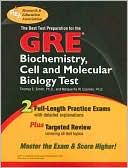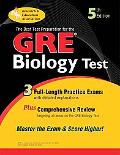GRE Biochemistry, Cell and Molecular Biology (REA) - The Best Test Prep
Search in google:
Prepare the right way for the GRE Biochemistry, Cell and Molecular Biology Test. Our exam experts will show you how to master the test and score higher. This completely revised and updated test prep contains 2 practice exams carefully derived from the latest GRE tests. Test questions are fully answered and thoroughly explained in easy-to-understand, step-by-step detail. The book's comprehensive review targets all topics appearing on the actual test including supramolecular complexes, metabolic pathways, genomics, and more. Follow up your study with REA's proven strategies and test-taking techniques.
TABLE OF CONTENTS INTRODUCTION Chemical Bonds and Energy Conservation Thermodynamics and Energy Conservation Potential Energy Curve Redox States Water, pH, Acid-Base Reactions, and Buffers Structure of Water Acid-Base Reactions Concept of Acids and Bases in Relationship to pH Buffers Biomolecular Structures Amino Acids and Proteins Structure of Proteins Primary Structure Secondary Structure a-Helix ß-Pleated sheets ß-Turns Tertiary Structure Quaternary Structure Chemical and Enzymatic Reaction Mechanisms Chemical Reaction Mechanisms PART 1: BIOCHEMISTRY Contents Introduction About This Book About REA's Test Experts About the Test Format of the GRE Biochemistry, Cell and Molecular Biology Test Scoring the Test Score Conversion Chart Test-Taking Strategies The Day of the Test During the Test Study Schedule First-Order Reactions Second-Order Reactions Some Factors That Influence Reaction Rates Enzymatic Reaction Mechanisms How Does an Enzyme Help Lower the Energy/Heat of Activation of a Reaction Proximity and Orientation Covalent Catalysis Strain and Distortion Acid-Base Catalysis Selected List of Coenzymes and Their Roles in Catalysis Classification of Enzymes by the Types of Reactions They Catalyze Oxidoreductases Transferases Hydrolases Lyases Isomerases Ligases Enzyme Kinetics Practical Aspect of Initial Velocity Measurement Lineweaver-Burk Plots Diagnostic Value of Lineweaver-Burk Plots: Enzyme Inhibition Classification of the Types of Enzyme Inhibitors Mechanism-Based Inhibitors Two-Substrate Reactions Sequential Reactions May Be Either Random or Ordered Ping-Pong or Double-Displacement Reactions Antibodies as Catalysts Regulation of Enzymatic Activity Summary of Regulatory Mechanisms Kinetic Models for Allosteric Regulation Kinetic Description of Allosteric Interactions: The Concerted Model Significance of the Hill Coefficient Metabolism Forms of Conserved Energy in Metabolism Glycolysis Reaction That Commits Glucose Metabolism to Glycolysis Aldolase Catalyzes the Production of Two -Carbon Compounds from Fru ,-P Triose Phosphate Isomerase Glyceraldehyde -Phosphate Dehydrogenase (GAPDH) Reaction Phosphoglycerate Kinase Reaction Phosphoglycerate Mutase Reaction Enolase Catalyzes the Second “High-Energy” Compound in Glycolysis Pyruvate Kinase Generates the Second ATP Molecule in Glycolysis Summary of Glycolysis Pyruvate Metabolism: Formation of Acetylcoenzyme A The Tricarboxyclic Acid Cycle (TCA Cycle) Regulation of the TCA cycle Anaplerotic Reactions for the TCA Cycle Oxidative Phosphorylation Pentose Phosphate Pathway Oxidative Phase of the Pentose Phosphate Pathway Nonoxidative Phase of the Pentose Phosphate Pathway Glucuronic Acid Oxidative Pathway Gluconeogenesis and Glycogenesis Summary of Entry Points in the TCA Cycle and Glycolysis That Can Lead to Gluconeogenesis Glycogen Metabolism Glycogenesis Glycogenolysis Regulation of Glycogen Metabolism Photosynthesis Photochemical Consideration of Light Absorption and Energy Generation Light Independent Reactions of Photosynthesis: The Calvin Cycle Adaptive Photosynthetic Mechanisms Nitrogen Metabolism Nitrogen Fixation Chemical Reactions of Pyridoxyl Phosphate Relative to Amino Acid Metabolism Biosynthesis of Amino Acids Amino Acids Derived from Oxaloacetate/Aspartate Amino Acids Derived from -Phosphoglycerate Cysteine Serine Glycine Amino Acids Derived from Pyruvate Amino Acids Derived from a-Ketoglutarate Amino Acids Derived from Phosphoenolpyruvate and Erythrose--phosphate Histidine Degradation of Amino Acids Methionine The Urea Cycle Nucleotide Structure and Metabolism Synthesis of Purines Summary of Key Points About Purine Biosynthesis Degradation of Purines Synthesis of Pyrimidines Synthesis of Deoxyribonucleotides Regulation of Ribonucleotide Reductase Activity Thymine Biosynthesis Degradation of Pyrimidines Heme Metabolism Heme and Chlorophyll Biosynthesis Heme and Chlorophyll Degradation Lipid Metabolism Fatty Acid Biosynthesis Elongation of Palmitic Acid Formation of Unsaturated Fatty Acids Nomenclature and Other Positions Where Desaturases Function Arachiodonic Acid and Signaling/Regulatory Molecules Cholesterol and Steroid Hormones Are Derived from Acetate Fatty Acids Are Stored as Triglycerides Sphingolipids Fatty Acid Oxidation Special Cases to Consider for b-Oxidation of Fatty Acids Methods Methods for Cell Disruption Mechanical Methods Nonmechanical Methods of Cell Disruption Separation of Cellular Components by Centrifugation Centrifugal Force Required to Pellet Selected Cellular Components Purification of Soluble Proteins Chromatography Ion Exchange Chromatography Hydrophobic Interaction Chromatography Gel Filtration Chromatography Affinity Chromatography High Performance Liquid Chromatography (HPLC) Isotopes Used to Study Biological Systems Radioactive Isotopes Stable Isotopes Relationship of Solute Concentration to Its Absorbance of Light Absorbance of Light and the Lambert-Beer Law Sample Analyses by Electrophoresis Polyacrylamide Gel Electrophoresis (PAGE) Two-Dimensional Gel Electrophoresis Determination of Molecular Mass Using SDS Denaturing Gels Western Blot Analysis Cellular Compartments of Prokaryotes and Eukaryotes Organization, Dynamics, and Functions Microscopy General Introduction to Prokaryotes and Eukaryotes Prokaryotes Eukaryotes Cell Death Apoptosis Necrosis Cellular Membrane Systems (Structure and Transport) Prokaryotic Cells, Plasma Membrane, and Cell Wall Eukaryotic Plasma Membranes and Cell Walls Membrane Biogenesis Membrane Transport Inactive Transport Active Transport Exo- and Endocytosis PART 2: CELL BIOLOGY Nucleus (Envelope and Matrix) and Chromosomes Prokaryotic Cells—Chromosome Eukaryotic Cells—Chromosomes and Nucleus Other Intracellular Structures, Including Mitochondria and Chloroplasts Prokaryotes Eukaryotes Specialized Structures and Other Characteristics Cell Dynamics Cell Surface and Cell Communication Extracellular Matrix The Extracellular Matrix of Connective Tissue Connective Tissue The Proteins of Connective Tissue The Extracellular Matrix of Endothelial Tissue Cell–Cell Interaction Binding of Cells to the Extracellular Matrix Communication between Extracellular Matrix and Cytoskeleton Cell Adhesion and Junctions: Cell–Cell Communication Signal Transduction and Receptor Function Cell Membrane Receptors Second Messenger Systems The cAMP Pathway The Phosphatidylinositol Pathway G-Protein-Associated Ion Channels Receptors That Are Enzymes Steroid and Thyroid Hormones Excitable Membrane Systems Cytoskeleton, Motility, and Shape Actin Filaments Actin in Muscle Contraction Microtubules Intermediate Filaments Organization of the Cytoskeleton Cell Surface Structures of Prokaryotes Protein Synthesis and Processing Cell Division, Differentiation, and Development Bacterial Cell Division Eukaryotic Cell Cycle Mitosis and Cytokinesis Cytokinesis Growth Factors Meiosis and Gametogenesis Fertilization and Early Embryonic Development Fertilization Embryogenesis Early Mammalian Development From Gastrula to Fully Developed Organism Positional Information Nuclear/Cytoplasmic Interactions Tissue-Specific Expression PART 3: MOLECULAR BIOLOGY Mendelian and Non-Mendelian Inheritance Punnett Square Diagrams Transformation, Transduction, and Conjugation Recombination and Complementation Mutational Analysis Genetic Mapping and Linkage Analysis Chromatin and Chromosomes Karyotypes Translocations, Inversions, Deletions, and Duplications Aneuploidy and Polyploidy Structure Genomics Genome Structure Repeated DNA and Gene Families Centromeres and Telomeres Gene Identifi cation Transposable Elements Gene Maintenance DNA Replication The Challenges of DNA Replication DNA Damage and Repair DNA Modifi cation DNA Recombination and Gene Conversion Branch Migration Gene Conversion The Genetic Code Transcription Gene Regulation in Prokaryotes Positive and Negative Control of the Operon Gene Regulation in Eukaryotes Cis- and Trans-Acting Regulatory Elements Gene Rearrangements and Amplifi cation Bacteriophages and Animal and Plant Viruses Genome Replication and Regulation Virus-Host Interactions Methodology Restriction Maps DNA Cloning in Prokaryotes and Eukaryotes Other Uses of Restriction Endonucleases Nucleic Acid Blotting and Hybridization PCR Sequencing and Analysis Protein-Nucleic Acid Interaction Site-Directed Mutagenesis Answer to Mapping Problem Practice Exams Answer Sheet: Practice Exam Practice Exam Answer Key Detailed Explanations of Answers Answer Sheet: Practice Exam Practice Exam Answer Key Detailed Explanations of Answers Index





